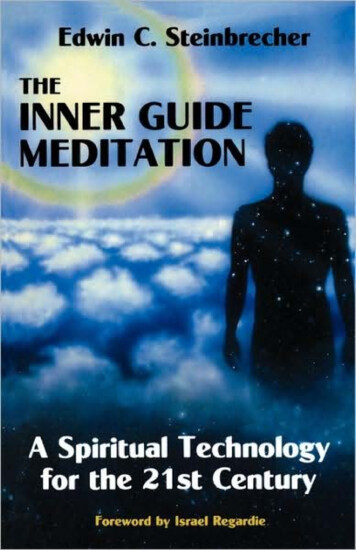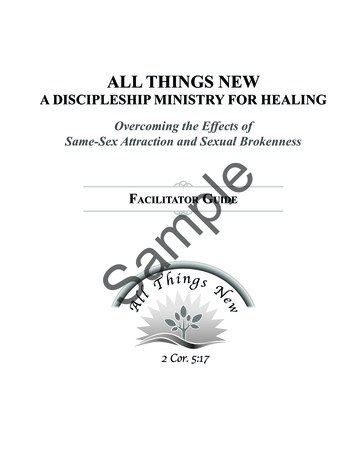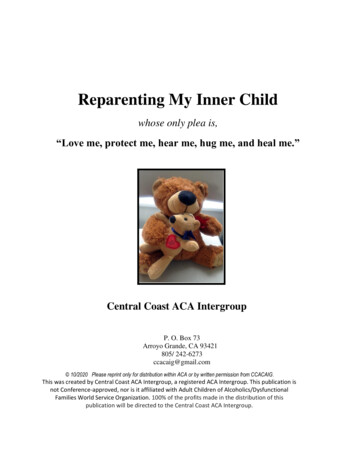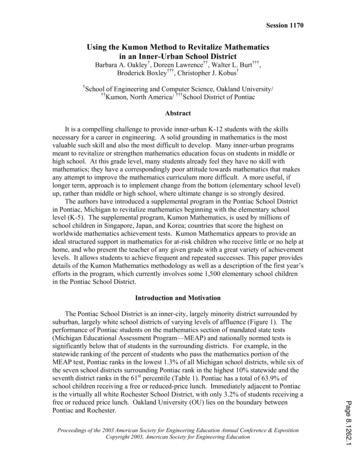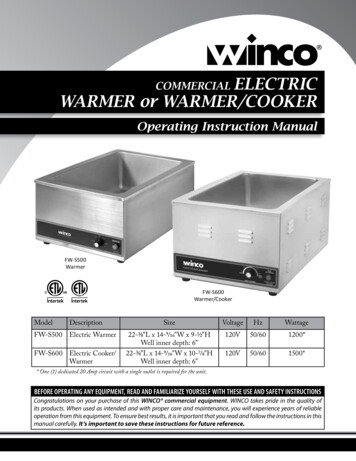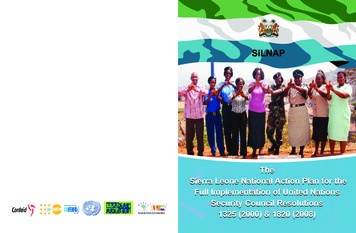
Transcription
SiLNAPWANMAR UNSCR 1325 TASKFORCETheSierra Leone National Action Plan for theFull Implementation of United NationsSecurity Council Resolutions1325 (2000) & 1820 (2008)
Table of Contents(i)(ii)(iii)(iv)PagePreface .Acknowledgments Abbreviations and Acronyms Executive Summary iiivvvii1: Introduction1.11.1.1General Background : The Global Context of UNSCR 1325 (2000) and UNSCR 1820 (2008)1886 (2009), 1888 (2009) and 1889 (2009) 2The Sierra Leone Context .3Elaboration of the Sierra Leone National Action Plan (SiLNAP) .72.12.27121.1.22:The Process of Developing the Sierra Leone National Action Plan.The Baseline Study 13: The Sierra Leone National Action Plan (SiLNAP) 3.1 Vision .3.2 Mission .3.3 National Action Plan Matrix 3.4 National Action Plan Budget Estimate . 3.5 Resource Mobilization for Full Implementation . ?Financing ?Advocacy ?Capacity Building 1314141421272727274: Monitoring and Evaluation Framework .4.1 Introduction to the M&E Framework .4.2 Institutional Readiness for Monitoring the Sierra LeoneNational Action Plan (SiLNAP) 4.3 Institutional Arrangement 4.4 Indicators for Monitoring the SiLNAP 4.5 Data requirement for Monitoring and Evaluation of the SiLNAP 4.6 Budget for implementing the M&E Plan 292930303333335.Conclusion 356.Appendices 367.Bibliography 41i
(I) PrefaceSierra Leone experienced eleven years civil war that brought socio-economic development to stagnation. Toredress this unwholesome state of affairs, the Government of Sierra Leone held negotiation with the thenRevolutionary United Front (RUF) and signed the Lome Peace Agreement. One of the manyrecommendations was to set up a Truth and Reconciliation Commission (TRC) with a mandate to investigatethe causes of the war and make recommendations to promote national healing and prevent reccurrence.The TRC made general recommendations and imperative recommendations on women1.The TRC found that women and girls were subjected to systematic abuse during the conflict such as 'torture,rape, sexual abuse, sexual slavery, trafficking, enslavement, abductions, amputations, forced pregnancy,forced labour and detentions. The TRC recommendations aimed at addressing the underlying causes of theconflict, prioritizing the elimination of laws and practices that discriminate against women and introducingeffective measures to address and reduce sexual and domestic violence.The United Nations Security Council Resolutions 1325 on Women, Peace and Security (2000) and 1820(2008) address the impact of war and conflict on women and girls including the recognition of andintervention on the gender dimension. Also, these Resolutions address women's contributions to conflictprevention, resolution, transformation, peace processes and peace building.The UNSCR 1325 as designed, is a tool for engendering peace and security process as It can leveragestrategic actions for equitable and sustainable interventions for inclusive security, peace and development,especially with respect to women and girls. Nine years on, since its adoption, progress on the ground indeveloping countries like Sierra Leone in translating the principles and provisions into practice has beenminimal, with little or no deliberate and coordinated actions. The UN Secretary-General mandatedmechanisms that are being encouraged and facilitated by UN Agencies in particular, OSAGI, INSTRAW,UNIFEM, UNFPA and Civil Societies. An essential step in the mechanism is for countries to develop NationalAction Plans (NAPs). This is a powerful tool for building national consensus and ownership in support of, aswell as, guiding effective implementation of the resolution.To nationally implement the global UNSCRs 1325 and 1820, Sierra Leone decided to develop the NationalAction Plan (NAP). The NAP was drafted through a rigorous and inclusive process which commenced inSeptember 2008. The final draft was adopted as the Sierra Leone National Action Plan (SiLNAP) inSeptember 2009 at a National Consultative Conference, attended by line Ministries, CSOs and UN Agencieswith support from Cordaid, Netherlands. To commence the process, a mapping survey was conducted toestablish a baseline on implementing UNSCR 1325 in Sierra Leone and provide data to inform the crafting ofthe SiLNAP. The survey report revealed among other challenges, low level of technical capacity for effectiveimplementation of UNSCR 1325. At the core of effective and practical translation of the provisions of 1325and 1820 on the ground, is for the SiLNAP to contain “SMART” monitoring and evaluation indicators andhighlight good practices for monitoring implementation.The SiLNAP has five pillars, with indicators, as follows:(1)(2)(3)1Prevention of Conflict including Violence Against Women and Children (SGBV)Protection, Empowerment of Victims and Vulnerable Persons especiallywomen/girlsProsecute, Punish Perpetrators effectively and Safeguard Women and Girls'Witness to Truth: Report of the Sierra Leone Truth and Reconciliation Commission, Vol. 2, p.168ii
7. Bibliography1. Conciliation Resources/CEDSA/MARWOPNET-SL/Search for Common Ground (2008)Peace, Security and Development Update 'Women in Security', March 2008, Issue 3.2.GOSL (2004) Census Reports by Statistics Sierra Leone/ UNFPA/UNIFEM (2008) 'SituationAnalysis Research on Gender Based Violence, Vol. I&II.3. GOSL (2004) Gender Mainstreaming Policy4. GOSL – Ministry of Social Welfare Gender and Children's Affairs (2009), National GenderStrategic Plan5. GOSL (2009) Policy on the Advancement of Women6. GOSL (2008) PRSP II – 'Agenda for Change'7. Thelma Ekiyor and L. Muthoni Wanyeki: National Implementation of security CouncilResolution 1325 (2000) on Women, Peace and Security in Africa – Needs AssessmentReport, prepared for the OSAGI and ECA, High-Level Policy Dialogue on NationalImplementation of the Security Council Resolution 1325 (2000) in Africa 6-8 February2008, Addis Ababa, Ethiopia.(4)(5)Human Rights to Protection during and post conflict as well as RehabilitateVictims/Survivors of SGBV and Perpetrators.Participation and Representation of Women.Promote Coordination of the Implementation Process, including ResourceMobilization, Monitoring and Evaluation of and Reporting on the National ActionPlan.The Resolution focuses on the three key areas namely: prevention, participation and protection of womenand girls in pre, during and post conflict periods. We must therefore ensure that our women and girls are byno means threatened by gender-based violence; otherwise one will hasten to say that there will never be areal chance for peace and security. We must collectively ensure that the needs of survivors of sexualviolence are recognized and addressed, and by so doing we will enhance the opportunity for building a morepeaceful and equitable society.As we approach the 10th and 2nd Anniversaries since the adoption of the important Resolutions 1325 onwomen, peace and security and 1820 on sexual violence respectively, it is very timely for our country todevelop the SiLNAP. However, it is sad to note that most women in conflict and post conflict situationscontinue to experience limited peace and security. We need to be proactive as government, UN System andCivil Society in ensuring that we implement the provisions of UN Security Council Resolution 1325 in SierraLeone. We have gone a long way but we still need to do more without complacency.Let me assure you of Government's sustained political will and commitment in the implementation of theSiLNAP by providing the leadership to the entire process.8. The Sierra Leone Women's Manifesto/Declaration: Action NOW – available from especiallythe 50/50 Group (SL), NOW (SL) and the Women's Forum (SL).9. UNIFEM (2009) Security Council Resolutions on Women, Peace and Security: GenderSensitive Peacemaking, Peacekeeping, PeacebuildingH. E. Dr. Ernest Bai KoromaPresident of the Republic of Sierra Leone10. UN-INSTRAW (208), “Planning for Action : Good Practices on Implementing UNSCR 1325on a National Level”, available athttp://www.instraw.org/image/fles Background paper 1325.pdf41iii
The Ministry of Social Welfare, Gender and Children's Affairs, WANEP-SL and MARWOPNET-SL remainvery grateful to Cordaid Netherlands for their financial support towards the development of this SiLNAP.We are also very grateful for the financial and technical support from the UN System especially UNFPA andUNIFEM in Sierra Leone.I am particularly grateful to the project core team comprising of staff from my Ministry, WANEP-SL, andMARWOPNET-SL for working tirelessly in coordinating the assessments, consultations, collatingstakeholders input, organising Taskforce meetings etc. Special thanks to Dr. Nana Pratt (NOWSL/MARWOPNET-SL), Edward Jombla (WANEP-SL), Agnes Farma (WANEP-SL), Mabel Kartusche (NOWSL/MARWOPNET-SL), Sullay M. Kallay (Permanent Secretary – MSWGCA), Fatou Y. Kargbo (Director,Gender, MSWGCA), Charles B. Vandi (Programme Officer –MSWGCA), John Manu (Ministry of Informationand Broadcasting), Ibrahim Karim Sei (Sierra Leone Association of Journalist), Elizabeth Sam (Gender,Research and Documentation Centre, University of Sierra Leone and Rosaline M’Carthy (Women’s ForumSL) Our grateful thanks go also to Mrs. Bernadette Cole (Chairman, Independence Media CommissionIMC) for her assistance in editing the document.Also, we appreciate the resources, services and inputs by Bineta Diop, Executive Secretary, Femme AfricaSolidarite (FAS) and Ecoma Alaga (WIPSEN-Africa) during the National Consultation.Many thanks and appreciation go to members of the National and Regional Taskforces on UNSCR 1325 and1820 for their invaluable contributions which led to the finalization of this plan.Hon. Dr. Soccoh KabiaMinister of Social Welfare, Gender and Children's Affairsiv40?Supports UN Action as host forSRSG; mechanism for coordinatingsystem-wide responses.?Develop mechanisms for protectingwomen/girls in/around UN-managedcamps (OP 10)?Recommendations invited for a Councilmechanisms for monitoring (OP 18)?Global indicators for 1325 with 6 months.(OP 17)?‘Special measures’ to protect women ?Civilian character of IDP/refugee campsand girls from SGBV (OP 10)(OP 12) PBC to address gender in peacebuilding (OP 14 and 19)?Calls on peacemaking efforts (andUN-appointed mediation teams inparticular) to address SV in conflict –resolution processes (OP 12)?Report every year on trends,situations, and providing details onparties to armed conflict crediblysuspected of perpetrating patterns ofrape.?Rapid within 3 months with proposalson improved monitoring and reportingon conflict-related SV?Women protection advisors (militaryand gender skills) in contexts withhigh levels of SVPresented by US?Calls for appointment for SRSG toprovide leadership and coordinatingfor UN response to SVPresented by US?Specific training of troops oncategorical prohibition of sexualviolence (OP 3; 6; 7)Presented by NamibiaPresented by Viet Nam?Women to participation in all?Women to participate in peace making andelements of peace making particularlypeacebuilding institutionspeace negotiations?SG to develop a strategy to increase?Placement of gender advisors innumbers of female peacemaking and peacemissionskeeping personnel (OP4)?Training humanitarian and?Placement of gender advisors and women?Welcomes coordination efforts of UNpeacekeeping personnel on protectionprotection advisors (as per 1888)rights and needs of women (OP 6)Action Against Sexual Violence in?Basic services for women and adequateConflict (ppxiv)?Need to maintain civilian character offunding for them (gender marker) (OP 8-10)refugee/IDP camps and design themincluding sexual and reproductive health?Scope for addressing root causes:in a way that helps prevent sexualand reproductive rights (for first time in a‘debunking myths that fuel sexualviolence (OP 12)SC resolution) OP 10)violence’ (OP 3)Prevention of and Response to Conflict-Related Sexual Violence18201888First SCR to recognize conflict-relatedStrengthens tools for implementingsexual violence as a matter of1820 through assigning leadership,international peace keeping, justice, and building judicial response expertise,peace negotiation responsereporting mechanisms.Women’s Leadership in Peace Making and Conflict Prevention13251889First SCR to link women to the peace and Addresses obstacles to women’s participationsecurity agenda addressing the impact of from peacebuilding planning and institutionswar on women and their contribution toand lack of adequate funding for their needs orconflict situation and sustainable peaceprovisions for their securityAcknowledgmentsKey elementsThis plan would not have come to a logical conclusion without Government's political will and commitmentwhich was manifested through the line ministries especially the Ministries of Defence, Internal Affairs, LocalGovernment and Rural Development, Information and Communication, Foreign Affairs and InternationalCooperation etc. I am also humbled by the active participation in all the processes by the Hon. Members ofParliament and the Office of the First Lady of the Republic of Sierra Leone.ResolutionelementsDescriptionThe Sierra Leone National Action Plan on UNSCR 1325 and 1820 is firmly rooted in the findings of thebaseline assessment/mapping survey and wider consultations conducted by the Ministry of Social Welfare,Gender and Children's Affairs in collaboration with WANEP-SL and MARWOPNET-SL. The process todevelop the Sierra Leone NAP on UNSCR 1325 and 1820 was conducted by a collaborative effort involvingGovernment through the Ministry of Social Welfare, Gender and Children's Affairs (MSWGCA), Civil SocietyOrganizations, other local NGOs as well as the UN Country Gender Team in particular the National TaskForce on 1325 led by WANEP (SL) and MARWOPNET (SL) (WANMAR), with funding support from Cordaid(Netherlands).Security Council Resolutions on Women, Peace and Security:Gender-Sensitive Peacemaking, Peacekeeping, Peacebuilding(ii)
391.5.1 Institutional mechanism,management and monitoring capacityof the government-Civil Society TaskForce strengthenedOutputsEnsure effective coordination of theImplementation Process includingResource Mobilization, Monitoringand Evaluation of and Reporting onthe National Action PlanOutcome 1.51.4.2 Recruitment and retention ofwomen in law enforcement, justiceand security institutions increasedNo. of capacity buildingtrainings on M& EconductedRequired institutionalmechanisms for effectivemonitoring andcoordination in placeCoordination enhanced atall levels includingimproved relationshipbetween Sierra Leone andManor River Union – subregional bodiesAdequate resources securedon implementationIncrease knowledge of thestatus of implementation of1325 and 1820 in MRUcountriesNumber of training sessionsto build capacity of theMSWGCA, FSU, RSLAFand other relevant partnersin the area of gender, peaceand security includinggender analysis and gendermainstreaming.Number and 30% of womenin decision-making and highranking positions at alllevels in SSIsIncrease in the % of womenrecruited and retained inSSIs by 30%MSWGCA,SiLNAP annualreportsMSWGCA,SiLNAP annualreportsMSWGCA,SiLNAP annualreports,M&Eunit setuplowTBCTBC 150,000Low0.00 TBC103%1%TBC5%3%40Operational2030Improved 400,000advancedUnitcapacitated1520Medium 300,000improvedReportingmechs inplace10enhanced sustained psMSWGCA,Women’sgroupsAnnuallyAnnually,MTR andFinalEvaluationAnnually(iii)Abbreviations and DAMARWOPNET (SL)MOFEDMSWGCANaC-GBVNAPNECNGSPNSCNOW (SL)OSAGIONSOPPROSECSPRSPIIRSCSSRAgenda for ChangeAdvocacy Movement NetworkAfrican UnionConvention on the Elimination of All Forms of Discrimination Against WomenChiefdom Security CommitteesCivil Society OrganizationsCommission on the Status of WomenCivil Society Peace Building Executive CommitteeDevelopment Aid Coordination AssistanceDistrict Security CommitteesEconomic Community of West African StatesEnhancing the Interaction and interface between Civil Society and Governmentto Improve Poor People's LivesFemmne Africa SolidariteFamily Support UnitGender Based ViolenceGovernment Civil Society Task forceGender Focal PointGender Research and Documentation CentreHuman Rights Commission Sierra LeoneIndependence Media CommissionMonitoring and EvaluationMinistries, Departments and AgenciesMano River Women's Peace Network (Sierra Leone)Ministry of Finance and Economic DevelopmentMinistry of Social Welfare Gender and Children AffairsNational Committee on Gender-Based ViolenceNational Action PlanNational Electoral CommissionNational Gender Strategy PlanNational Steering CommitteeNational Organisation for Women Sierra LeoneOffice of the Special Assistant on Gender IssuesOffice of National SecurityOperative Paragraph (of the Resolution)Provincial Security CommitteesPoverty Reduction Strategy Paper IISteering CommitteeSecurity Sector Reformv
vi381.4.1 Stakeholders lobbied forincreased representation and genderparity in decision making organsincluding 30% quota for politicalrepresentation.OutputsContribute to increased participationand representation of womenOutcome 1.41.3.3 reporting of SGBV cases atnational and community levelsincreasedIncrease in the no. ofMagistrates, Lawyers andJudges1.3.2 institutional and othermechanisms in the justice sectorstrengthened to prevent and respond tosexual violenceLegislation and regulatorymeasures ensuring genderparity or a minimum of 30%at all elected and appointedpositions in government, aswell as other governanceNumber of advocacy andConsultative Sessionsconducted for stakeholders(political parties,legislature, women’sgroups, civil society etc).% increase in women’sparticipation in running forpublic offices% increase in representationof women in political officeand public officeincrease in the no. of casesreported to law enforcementagenciesaddressing /handling SGBVcasesIncrease in the no. ofvictims receivingreparations supportMSWGCA,SiLNAP annualreportsHRCSL,MSWGCA,SiLNAP annualreportsFSU AnnualreportMSWGCA, FSU,JSCO, HRCSL,MOJ reportsMSWGCA,HRCSL, NaCSAReparationreportsTBC15%927 reportedcases for 2009Bills andpoliciesdraftedandpopulariz1020%15010, 30, 10100Bills andpoliciespassed2018%30015, 50, 15250Laws andpoliciesimplemented3030%45020, 70, 20450Laws andpoliciesinstitutionalized and4035%60025, 80, 25600Signs ofsustainability5040%90030, 90, R andFinalEvaluationAnnuallyAnnuallySexual and Gender Based ViolenceSierra Leone Fire ForceTruth and Reconciliation CommissionSierra Leone National Action PlanUnited NationsUnited Nations Gender Theme GroupUnited Nations Population FundUnited Nations Development FundUnited Nations Security Council Resolution 1325 (October 2000)United Nations Security Council Resolution 1820 (June 2008)West Africa Network for Peacebuilding-Sierra LeoneWomen in Peacebuilding and Security Network - AfricaWomen in Security Sector, Sierra Leone1.3.1 Government advocated to fullyimplement the recommendations of theTRC report on WomenKey OutputsSGBVSLFFTRCSiLNAPUNUNGTGUNFPAUNIFEMUNSCR 1325(2000)UNSCR 1820 (2008)WANEP-SLWIPSEN-AfricaWISSIL
Annually,MTR andFinalEvaluation74%55%Since the adoption of UNSCR 1325 and 1820, there has been active international lobby for the application ofthese instruments by various interested parties. These have been strengthened by the adoption of otherresolutions such as 1886, 1888 in September and 1889 October 2009. Despite the unanimous adoption ofthese policy frameworks, the development of National Action Plan for full implementation of the resolutionsremains a challenge. Therefore, the urgency and need for building a viable constituency for the application ofUNSCRs 1325 and 1820 cannot be over emphasized.For this reason, Sierra Leone started deliberations and discussions at translating Government'scommitment into action for the full implementation of UNSCR 1325 at a high level policy meeting organizedby the ECA and OSAGI in Addis Ababa in February 2008. This was followed by development and submissionof a comprehensive proposal to CORDAID Netherlands for funding. This effort became a reality with theavailability of the needed resources and the inception of a national taskforce comprising Government lineministries, Parliamentarians, UN Agencies, WANEP-SL, MARWOPNET, Civil SocietyOrganisations/Coalitions, Interfaith Groups, Traditional Leaders and the Media with the Ministry of SocialWelfare, Gender and Children's Affairs taking the lead. This team was later expanded to include other actorsat regional, district and chiefdom levels. Once the Terms of Reference of the Government-Civil Society TaskForce was established, the process continued further into the implementation of the project activities.15%5%Out of 927reported nonwas convicted.FSU report45%40%30%In this regard, the first activity was a nationwide mapping survey to establish a baseline of existing initiativeson 1325 in Sierra Leone. The survey generated data/information which determined existing knowledge gapsand identified priority issues for crafting the National Action Plan.50% increase in the number75% of reported casescharged and successfullyprosecuted by lawenforcement agenciesOutcome1.3Contribute to increased prosecution ofperpetrators as well as rehabilitation ofvictims.10%40% Increase in the numberof vulnerable women andgirls benefiting from suchprograms5%20%97531T.B.CReports fromMSWGCA,HRCSL, FSU,NaCSA1.2.2 Government measures andbenefits for women and girls invulnerable situation increased toensure the respect for their social andeconomic rightsincrease in the number ofnew government programsskewed to wards benefitingvulnerable women and girls30%15%70% increase in the no ofvictims having access tolegal aid37Executive SummaryThe United Nations Security Council Resolution 1325 (2000) on Women, Peace and Security and 1820(2008) on sexual violence were adopted by the UN Security Council as policy instruments. Theseinstruments facilitate and strengthen women's effort in conflict prevention, resolution, peacebuilding,recognize and provide early response mechanisms to address the impact of sexual violence and genderbased violence on women and girls during armed and unarmed %55%40%50%15%30%increase in the numberof victims receivingpsychosocial support1.2.1 health (psychosocial), economicand legal support provided tovulnerable persons including victimsand survivorsKey Outputs50% no. of victimsreceiving economic supportincluding s30%20%5%2%T.B.CReport fromInstitutionspreventing andresponding toGBV10%30%30% reduction of violenceon victims due toempowerment supportreceivedContribute to increased protection,Empowerment and support of Victimsand Vulnerable Persons especiallywomen/girlsOutcome 1.250% increase in the numberof women with increasedfeeling of protection fromSGBV in their communitiesReport fromInstitutionspreventing andresponding toGBV5%1%T.B.C10%20%Annually,MTR ��sgroups(iv)One thousand survey questionnaires were administered, but only 697 (70%) were completed. The findingsof the survey revealed mixed lessons with regard to knowledge of the Resolution, which was particularly lowin rural communities. Many activities on the Resolution were ongoing, but were done unconsciously andwere uncoordinated. Also, identified as a challenge to application, was the weak capacity of staff both atgovernment and NGO levels and within communities. In addition, there are policy and frameworkdocuments like the Gender Acts 2007 and the National Gender Strategic Plan that complement theResolution. Knowledge of the Resolution was obtained mainly through radio listening and workshops.Interestingly, 95% of respondents indicated their willingness to align their activities to the provisions ofUNSCR 1325 as well as support the process of developing and implementing an action plan. The surveyalso gathered that there was need to develop a capacity building programme for the effectiveimplementation, monitoring and evaluation of the UNSCR 1325 and 1820 nationwide.The next activities were the regional consultations in Kailahun, Makeni, Bo and Freetown. Thirty participantswere drawn from each region. The outcomes included issues relating to SGBV, access to relevantinformation and recommendations which provided inputs for the elaboration of the National Action Plan. Allthe priority outcomes were combined into a composite matrix that served as a working document in thenational consultation.vii
viiiAnnuallyPut in stagesin theprocessDomestication of theprotocolImplementation of theprotocol1.1.3 Legal environment for theprotection of women’s rights andsecurity improvedRatification anddomestication of AUWomen’sProtocolby Parliament.No. of bylaws in support ofprevention passed incommunitiesNumber of relevant lawsand instruments ratified and/ or domesticatedInstrument ofratification fromMoFAT.B.CTablingandratification ofprotocolinPreparation ofcountryreport onPopularization andcommunitysensitization on theEnforcement of the LawEnforcement of the LawDeveloproll-outplanLawsmonitored andupheldBy lawspassedBy gationon dutybearers toupholdSilNAP annualreportNumber of village levelcommunity structuresformed and networking tochampioning SGBV relatedabuses1.1.2 policies, mechanisms andprocedures for prevention ofconflict/violence against women,instituted at community level36Passageof SexualOffencesBillSigns CA,Women’sgroups1,200900600300100403.9m403.9 millionleonesAnnual budgetallocation byGovt.Increase in the level offinancial commitment byGovernment to Le 1.5 bn ofnational budget1.1.1 Commitment for theimplementation of resolution 1325 and1820 by related Governmentinstitutions increasedKey OutputsT.B.C1.2bn1bn600mImprovedImprovedLowState of Humanrights reportIncreased respect for therights of %927 reportedcasesFSU AnnualReportReduced rate in SGBV by50% by 20141.1 Contribute to reduced Conflictincluding Violence AgainstWomen/Children (SGBV)Outcome 1.1MSWGCA,Women’sgroupsAnnuallyAnnually,MTR t50%2014201320122011Annual Targets2010Overall ObjectiveIn conclusion, it is not enough to only have a policy framework that promotes gender equality women'sempowerment and peacebuilding. What is also needed as an element in the next steps is ensuring thatrelevant national budget sources among others, become available for the implementation of the SiLNAP.Therefore Resource Mobilization Strategy for financing and monitoring implementation of the Plan is6. AppendicesHowever, a plan on a piece of paper will not mean much for development, if there is no well definedmanagement, monitoring and evaluation component. This made us to consult local experts from othergovernment line ministries and the UN to develop a monitoring and evaluation (M&E) framework. The M&Eframework is anchored on participatory and community based engagement. Also, it is imperative that theSILNAP be aligned with the Sierra Leone second Poverty Reduction Strategy (PRS) – An Agenda forChange and other institutional and policy frameworks for sustainability.The full implementation of the Sierra Leone National Action Plan (SiLNAP) on UNSCRs 1325 and 1820 forthe period 2010-2013 has been budgeted for, to the tune of USD 21,301,314PersonsResp.From time to time, we continued to raise awareness and understanding of the general public on theprinciples, objectives and provisions of the Resolutions as well as drafting Sierra Leone National Action Plan.Most of the feedbacks from these programs helped immensely to shape and fine tune what should go into thefinal Sierra Leone National Action Plan (SiLNAP) on UNSCRs 1325 and 1820.BaselineAnother activity was tailored to inform and lobby Parliamentarians to support the process and makecommitment to its approval and application. The occasion was climaxed by a shared vision with members ofParliament to facilitate and respond to women's urgent demand to translate the UN 1325 with practicalintervention particularly at constituency level. Since then, the Sierra Leone Parliament remains engaged andcommitted to the implementation of the SiLNAP.Means ofVerificationIn our drive to get a doable Sierra Leone National Action Plan (SiLNAP), UNFPA and UNIFEM supported aworkshop to sharpen the indicators of the Action Plan. What came out clearly was a thorough review ofpriorities in the area of the objectives, activities and indicators of the draft plan.Measurable IndicatorsThese Pillars reflect priority issues of women's needs and concerns from a gender perspective. Theyencompass outcome and output objectives, strategies, activities and relevant indicators. There are fiveoutcome objectives, fourteen output objectives and thirty-five indicators.SiLNAP Objectives4.5.Prevention of conflict including violence against women/children (SGBV)Protection, empowerment of victims/vulnerable persons especially women and girlsProsecute, punish perpetrators effectively and safeguard women/girls' human rights toprotection (during and post-conflict) as well as rehabilitate Victims/Survivors of
prevention, resolution, transformation, peace processes and peace building. The UNSCR 1325 as designed, is a tool for engendering peace and security process as It can leverage strategic actions for equitable and sustainable interventions for inclusive security, peace and development, especially with respect to women and girls.
